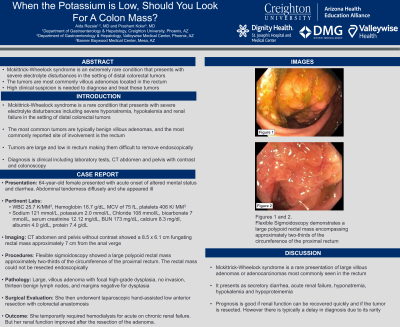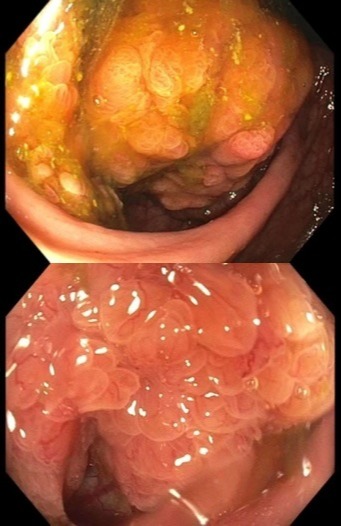Back


Poster Session E - Tuesday Afternoon
Category: General Endoscopy
E0288 - When the Potassium Is Low, Should You Look for a Colon Mass?
Tuesday, October 25, 2022
3:00 PM – 5:00 PM ET
Location: Crown Ballroom

Has Audio

Aida Rezaie, MD
Creighton University
Phoenix, AZ
Presenting Author(s)
Aida Rezaie, MD1, Prashant Kolar, MD2
1Creighton University, Phoenix, AZ; 2Banner Health, Mesa, AZ
Introduction: Mckittrick-Wheelock syndrome is a rare condition that presents with severe electrolyte disturbances including severe hyponatremia, hypokalemia and renal failure in the setting of distal colorectal tumors. The most common tumors are typically benign villous adenomas, and the most commonly reported site of involvement is the rectum. The tumors are typically large and low in the rectum making them difficult to remove endoscopically. Diagnosis is clinical including laboratory tests, Computed tomography (CT) abdomen and pelvis with contrast and colonoscopy.
Case Description/Methods: 64-year-old female presented with acute onset of altered mental status and diarrhea. She was hemodynamically stable. Physical exam was notable for tenderness to palpation diffusely over her abdomen and she appeared ill. Her white blood cell count was 25.7 K/MM3, hemoglobin 16.7 g/dL with an MCV of 75 fL, and platelets 406 K/ MM3. Her chemistry panel showed a sodium 121 mmol/L, potassium 2.0 mmol/L, Chloride 108 mmol/L, bicarbonate 7 mmol/L, serum creatinine 12.12 mg/dL, BUN 173 mg/dL, calcium 8.3 mg/dl, albumin 4.0 g/dL, protein 7.4 g/dL, aspartate aminotransferase 41 U/L, alanine aminotransferase 25, alkaline phosphatase 83 U/L, bilirubin total 0.9 mg/dL. CT abdomen and pelvis without contrast showed a 8.5 x 6.1 cm fungating rectal mass approximately 7 cm from the anal verge. Flexible sigmoidoscopy showed a large polypoid rectal mass approximately two-thirds of the circumference of the proximal rectum. Pathology was consistent with a tubular adenoma without high grade dysplasia or malignancy. The rectal mass could not be resected endoscopically. She required hemodialysis for acute on chronic renal failure. She then underwent laparoscopic hand-assisted low anterior resection with colorectal anastomosis. Final pathology was consistent with a large, villous adenoma with focal high-grade dysplasia, no invasion, thirteen benign lymph nodes, and margins negative for dysplasia.
Discussion: Mckittrick-Wheelock syndrome is a rare presentation of large villous adenomas or adenocarcinomas most commonly seen in the rectum. It presents as secretory diarrhea, acute renal failure, hyponatremia, hypokalemia and hypoproteinemia. Prognosis is good if renal function can be recovered quicily and if the tumor is resected. However there is typically a delay in diagnosis due to its rarity.

Disclosures:
Aida Rezaie, MD1, Prashant Kolar, MD2. E0288 - When the Potassium Is Low, Should You Look for a Colon Mass?, ACG 2022 Annual Scientific Meeting Abstracts. Charlotte, NC: American College of Gastroenterology.
1Creighton University, Phoenix, AZ; 2Banner Health, Mesa, AZ
Introduction: Mckittrick-Wheelock syndrome is a rare condition that presents with severe electrolyte disturbances including severe hyponatremia, hypokalemia and renal failure in the setting of distal colorectal tumors. The most common tumors are typically benign villous adenomas, and the most commonly reported site of involvement is the rectum. The tumors are typically large and low in the rectum making them difficult to remove endoscopically. Diagnosis is clinical including laboratory tests, Computed tomography (CT) abdomen and pelvis with contrast and colonoscopy.
Case Description/Methods: 64-year-old female presented with acute onset of altered mental status and diarrhea. She was hemodynamically stable. Physical exam was notable for tenderness to palpation diffusely over her abdomen and she appeared ill. Her white blood cell count was 25.7 K/MM3, hemoglobin 16.7 g/dL with an MCV of 75 fL, and platelets 406 K/ MM3. Her chemistry panel showed a sodium 121 mmol/L, potassium 2.0 mmol/L, Chloride 108 mmol/L, bicarbonate 7 mmol/L, serum creatinine 12.12 mg/dL, BUN 173 mg/dL, calcium 8.3 mg/dl, albumin 4.0 g/dL, protein 7.4 g/dL, aspartate aminotransferase 41 U/L, alanine aminotransferase 25, alkaline phosphatase 83 U/L, bilirubin total 0.9 mg/dL. CT abdomen and pelvis without contrast showed a 8.5 x 6.1 cm fungating rectal mass approximately 7 cm from the anal verge. Flexible sigmoidoscopy showed a large polypoid rectal mass approximately two-thirds of the circumference of the proximal rectum. Pathology was consistent with a tubular adenoma without high grade dysplasia or malignancy. The rectal mass could not be resected endoscopically. She required hemodialysis for acute on chronic renal failure. She then underwent laparoscopic hand-assisted low anterior resection with colorectal anastomosis. Final pathology was consistent with a large, villous adenoma with focal high-grade dysplasia, no invasion, thirteen benign lymph nodes, and margins negative for dysplasia.
Discussion: Mckittrick-Wheelock syndrome is a rare presentation of large villous adenomas or adenocarcinomas most commonly seen in the rectum. It presents as secretory diarrhea, acute renal failure, hyponatremia, hypokalemia and hypoproteinemia. Prognosis is good if renal function can be recovered quicily and if the tumor is resected. However there is typically a delay in diagnosis due to its rarity.

Figure: Figures 1 and 2: Flexible Sigmoidoscopy demonstrates a large polypoid rectal mass encompassing approximately two-thirds of the circumference of the proximal rectum.
Disclosures:
Aida Rezaie indicated no relevant financial relationships.
Prashant Kolar indicated no relevant financial relationships.
Aida Rezaie, MD1, Prashant Kolar, MD2. E0288 - When the Potassium Is Low, Should You Look for a Colon Mass?, ACG 2022 Annual Scientific Meeting Abstracts. Charlotte, NC: American College of Gastroenterology.
